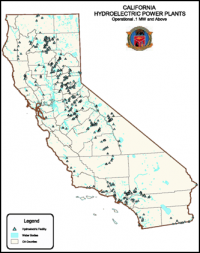California's hydroelectricity production is vulnerable to climate change

(ĖĮÐÄĘÓÆĩ) -- Californiaâs hydropower is vulnerable to climate change, a University of California, Riverside scientist has advised policymakers in âOur Changing Climate,â a report released July 31 by the California Natural Resources Agency and the California Energy Commission (CEC).
âClimate change is expected to affect the quantity and timing of water flow in the state,â explained Kaveh Madani, a former postdoctoral research scholar in UC Riversideâs Water Science and Policy Center (WSPC), who led a research project on climate change effects on hydropower production, demand, and pricing in California. âUnder dry climate warming, the state will receive less precipitation, with most of it as rain instead of snow, impacting hydropower supply and operations.â
On average, 15 percent of Californiaâs electricity comes from hydropower, a cheap and relatively clean energy source. About 75 percent of this hydropower comes from high-elevation units, located above 1,000 ft. The state has more than 150 high-elevation units, with most of them located in Northern California and the Sierra Mountains. The majority of the high-elevation reservoirs are small in terms of their storage capacity, being built only for hydroelectricity production and no other benefits, such as water supply and flood control.
âIf California loses snowpack under climate warming, these high-elevation reservoirs might not be able to store enough water for hydropower generation in summer months when the demand is much higher and hydropower is priced higher,â said Madani, currently an assistant professor of civil, environmental, and construction engineering at the University of Central Florida. âCalifornia might, therefore, lose hydropower in warmer months and hydropower operators may lose considerable revenues.â
Madani, who led UCRâs only research team for CECâs third climate change assessment studies, explained that the major cause of revenue loss is that hydropower prices are expected to decrease in colder months of the year and increase in warmer months.
âThe big problem is that hydropower will be less available when it is most needed and expensive: in the summer months,â he said. âA warmer California needs more electricity for cooling in summer months and less electricity for warming in winter months. This means that hydropower pricing patterns will be affected by climate change. It is important to analyze climate change effects on this renewable energy source early on to figure out what strategies are available to adapt to the new conditions and thereby minimize the potential negative impacts of climate change on hydropower.â
Madani explained that, on average, California could lose up to 20 percent of its hydropower generation under dry climate change, which can result in 8 to 18 percent reduction in hydropower revenues for producers.
âOur results do not yet suggest that we need to build more dams in California for hydropower generation,â said Madani, who was recently selected as one of the 10 New Faces of Civil Engineering in 2012 by the American Society of Civil Engineering. âBut they suggest that hydropower, a highly valuable energy source, may be less available. So we have to look for clean replacements and we have to reduce our energy demands as much as we can.â
Madani began his research on climate change effects on Californiaâs hydropower as a graduate student at UC Davis, where, along with a colleague, he developed an âEnergy-Based Hydropower Optimization Modelâ (EBHOM) that covers more than 150 high-elevation hydropower units in California. An optimization model, EBHOM prescribes the best operation policies in response to the changes in climatic conditions.
A new version of the model that Madani developed can estimate changes in hydropower pricing and demand in response to temperature changes.
âIt helps us consider the effects on supply and demand simultaneously,â Madani said of the modelâs new version. âBut modeling studies have limitations that need to be addressed as more data become available and the science improves. Future studies need to have a closer look at the environmental side of this problem. Changes in operations of the high-elevation systems should be done after careful consideration of all possible environmental damages.â
Madaniâs research at UCR was funded by CEC. As the principal investigator of the research project, he worked with fellow-researchers at Lund University, Sweden; the University of Central Florida; and the Bourns College of Engineering at UCR.
Madaniâs postdoctoral research took place during 2009-2010 at the WSPC, where he closely worked with Ariel Dinar, its director.
âI am an engineer and Ariel is an economist,â Madani said. âWe talk different languages and sometimes might think differently about the same problem. The different views helped me learn many new things and gave me the ability to think out of the engineering thinking box. Working at the WSPC was thus a true interdisciplinary research and education experience for me.â
More information:
Provided by University of California - Riverside
















